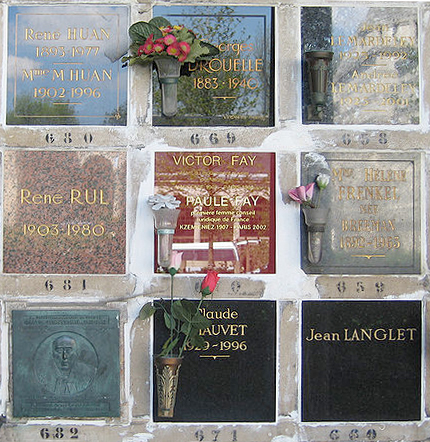A columbarium is a specially designed room or building with niches for cinerary urns (cremation urns) to be stored, much like a mausoleum. There is a trend in the monument industry toward using the word mausoleum for both bodies and ashes (cremains), instead of the older term ‘columbarium’.
Types of columberia
 Modern columbarium designs are simple and tasteful. Some columbaria disappear into their surroundings, such as a garden wall, while in others have highly customizable niches. They are typically constructed similar to mausoleums and out of the same materials. You will find both indoor and outdoor columbaria at both churches and cemeteries. Indoor columbaria may offer climate controlled niches.
Modern columbarium designs are simple and tasteful. Some columbaria disappear into their surroundings, such as a garden wall, while in others have highly customizable niches. They are typically constructed similar to mausoleums and out of the same materials. You will find both indoor and outdoor columbaria at both churches and cemeteries. Indoor columbaria may offer climate controlled niches.
Columbarium niches vary in size, and some allow for two urns to be placed together. Sections of columbaria may be designated for entire families. Depending on the cremains vessel selected, there may be limited space for small memorabilia.
Where are columbaria located?
Columbaria are usually located in a cemetery, but can also be built into churches or are located on church grounds. A columbarium can take various forms, but in a church building they are usually located in an interior wall. They can also be constructed in the churchyard, garden or a cemetery in various shapes and sizes. In some cases, one area or wing inside of a mausoleum is designated for cremains. Some are permanently sealed niches, where as others the face front panel is unlocked. The name of the deceased is usually inscribed into this panel.
Why buy a columbarium niche?
While some prefer the idea of scattering ashes, others would rather have specific place to visit their deceased loved ones. A columbarium allows family and friends a place to pay their respects to the departed.
When to buy a columbarium niche
Just like buying a cemetery plot or mausoleum space, columbarium niches are purchased in perpetuity. Most niches can be purchased at anytime, as long as space is available.
Columbarium alternatives
In addition to columbaria, many cremation facilities also offer water and garden scattering services. These gardens are sometimes referred to as scatter gardens.
History of columbaria
The Romans were the first to use columbariums to store cremains in highly decorated urns. These columbaria were underground and also elaborately decorated with mosaics, frescoes and more. The term comes from the Latin columba (dove) and originally referred to the compartmentalized housing for doves and pigeons, called a dovecote.
In ancient Japan, Buddhist temples used a similar way to store ashes called a nokotsudo.
Famous Columbaria
- Golders Green Crematorium – First crematorium in London and houses 3 columbarias containing the remains of thousands of Londoners.
- Père Lachaise Cemetery & Columbaria – the largest cemetery in the city of Paris, France.
- Neptune Society Columbarium – Large, copper-domed columbarium built in 1898 in San Francisco CA.
If no arrangements were made life, choosing whether to use a columbarium or scatter ashes is a completely personal decision for the family of the departed. Your loved one’s final resting place should be somewhere you can visit and feel at peace. You might even consider planting your own memorial garden.
Photo above via Wikipedia Commons.
Tags: Cremains, Cremation, Cremation Urns, Mausoleum, Monuments